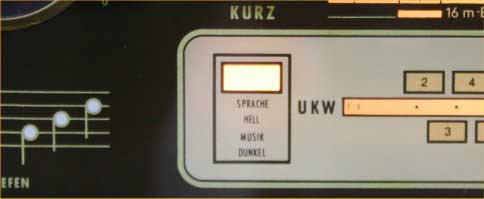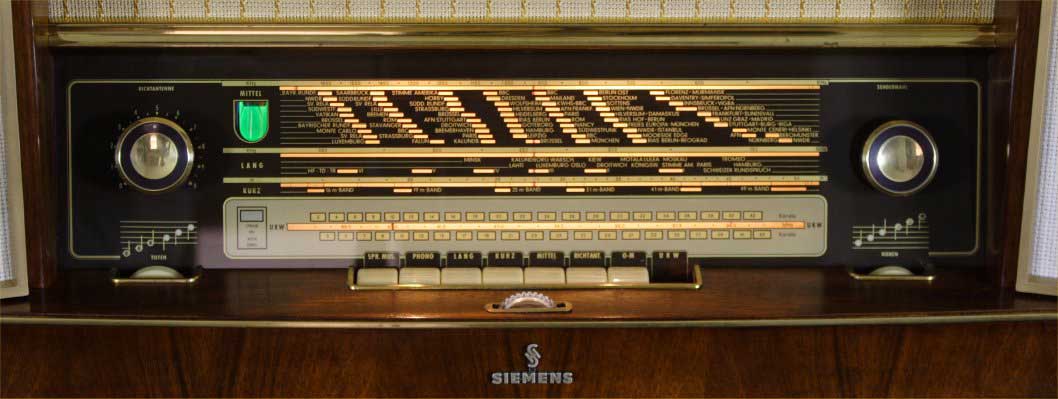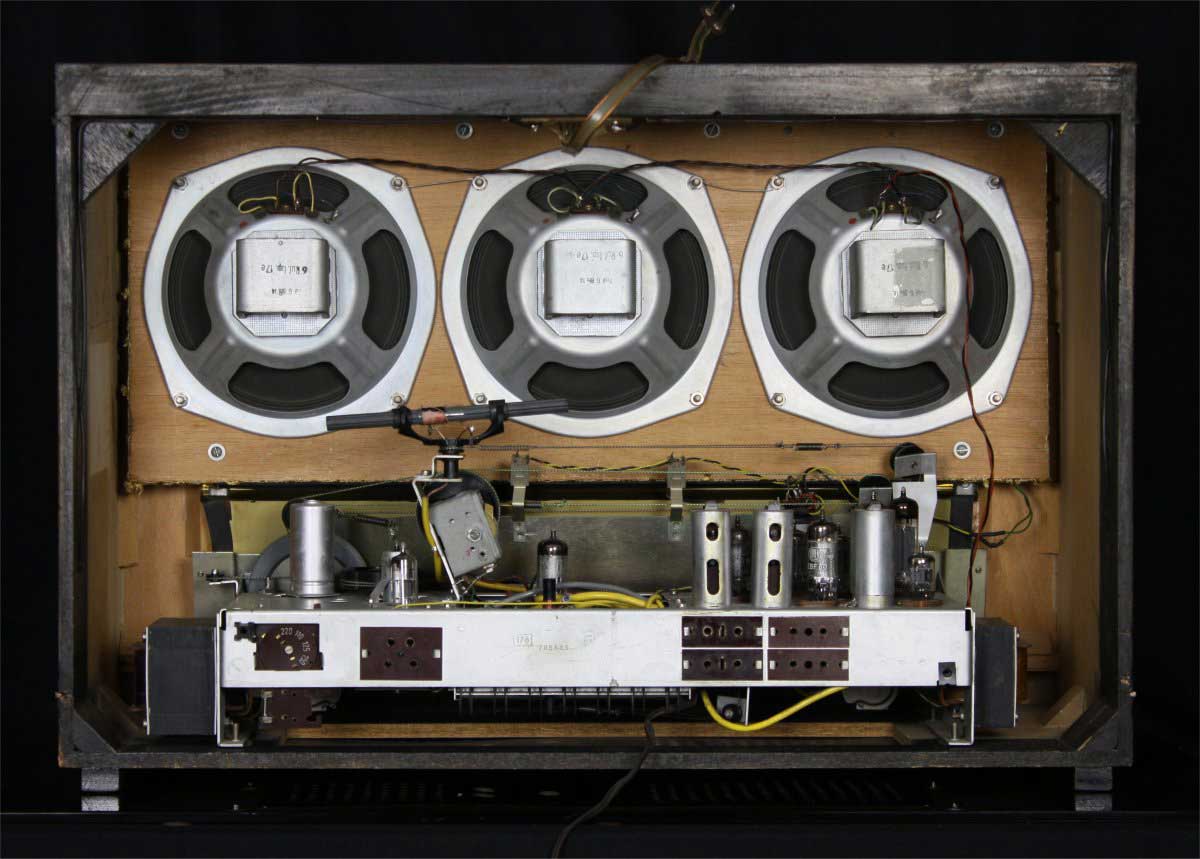 meistersuper 843w - en
meistersuper 843w - en
Siemens Meistersuper 843W – en
- 8th March 201911th February 2021
- by giovanni
Siemens Meistersuper 843W

Siemens Meistersuper 843W
The Siemens Meistersuper 843W was produced between 1954 and 1955 and had a good sales success, even though the lion's share was taken by the models of the Schatulle series.
The most interesting feature of this device is the unusual combination of the two large elliptical loudspeakers (26x18 cm) and the class A output stage.
The two large loudspeakers, equipped with a 10.000 Gauss magnet, can easily withstand the power developed by the final EL84. From the musical point of view, the quality of these speakers correspond to a very extended and rich bass frequency response. At the same time, the linearity of the class A amplifier provides soft and bright mid and high tones.
The cabinet is very refined.
The large size needed to include the two big loudspeakers are mitigated by some stylistic solutions that were later adopted on many models.
The side walls are, in fact, raised compared to the front side. The corners are rounded with different radii of curvature between the lower and upper sides. The streaks of the coating, moreover, are placed orthogonally to those of the front. Besides, the streaks of the edges are very pronounced. Finally, two thin golden lines interrupt the front edges in width.
All these expedients slim down the large cabinet, making it very pleasing to the eye as for its overall balance.
Moreover, the coatings were chosen and combined with ancient mastery, making the most of the contrast created by the streaks.
In this restoration we have tried to bring this cabinet back to its lively original character, without softening it nor hiding anything.
The tuning stability allows to find again a perfectly centred station, even if the radio has not been switched on in a few days.
The mechanics are “simple” and sturdy. The electronic parts are quite complex, but they have been completely restored, so no fear.
BLUETOOTH
Bluetooth receiver embed
MULTI PLATFORM CONNECTION
Each radio is equipped with a cable for connection to any digital device.
TUBESOUND IMPROVEMENT
- Bluetooth receiver embed - The unit is equipped with a BLUETOOTH receiver powered directly by the receiver power supply. This makes it possible to control the amplifier from any external digital device as an IPAD, a Smartphone, or a sophisticated multimedia station. So you can hear your preferred web station or your lossesless file without cables on the room. Wireless Receiver can be equipped upon requests.
- Multi Platform Connection - A customized adaptation cable to connect any digital device as Iphone, Smartphone, Laptop, CD Player etc. will be provided with this radio. This special cable suits the different impedances between the modern equipment and the receiver. Furthermore the two stereo channels flow into one without increasing the load to the input unit.
MAIN FEATURES
Year of production: 1954/1955
Superheterodyne IF: 468/10700
6 AM Circuits
9 FM Circuits
Wavebands:
Medium Waves(OM), Long Waves(OL), Short waves(OC), FM(UKW)
Power supply: (AC)
110; 125; 160; 220 Volt
Loudspeakers
2 x wideband 10" x 7"
Dimensions (LHD): 620 x 420 x 290 mm / 24.4 x 16.5 x 11.4 inch
Net weight: 13 kg / 28 lb 10.1 oz
Tubes 7: EF80 EC92 ECH81 EF89 EM80 EABC80 EL84

TONE CONTROL WITH LEVEL INDICATION
The tones control system is very efficient. Above the large tone control knobs there is a band that lights up gradually indicating the emphasis on the band on which it acts.
AERIALS
Inside the cabinet there is a dipole for FM reception and a ferrite rotating aerial for AM reception.
Ferrite aerial can be rotated from the outside to achieve a perfect tuning of the device in the AM.
In this picture see the rotation mechanism and the position indicator of the aerial.
The reception sensitivity with internal aerials is very good. This unit was in fact produced in a period when there were not many radio stations and those available fairly apart from each others.
Using an external aerial sensitivity is further increased.


SEPARATE CONTROL TUNING BETWEEN AM AND FM
The unit is equipped with mechanisms that control separately the AM band tuning and the FM band.
The tuning knobs are coaxial.
The largest crown controls the AM bands (short, medium and long waves).
The frontal knob, smaller, controls the FM band.
TUNING INDICATOR
The magic eye has of course been replaced.

LOUDSPEAKERS
There are two loudspeakers, actually very large. In the long side they measure 26 cm and 18 cm in the short side.
Apart from being large, they are equipped with an alnico magnet that guarantees a 10.000 Gauss magnetic flux density.
The resulting efficiency is noticeable, so very little power is enough to produce a very high sound pressure.
Moreover, the profile of the cone is slightly trumpet-shaped, so that the high frequencies are effectively reproduced in the central part of the cone and the rest of the profile contributes to adapt the acoustic impedance between the membrane and the surrounding air.
The result is a very extensive reproduction, both at low and high frequencies.
It is no coincidence that this is one of the few devices with a single-ended amplifier that easily support the bass of the Area's track Luglio, Agosto, Settembre (Nero).
CONTROL PANEL

To the left is the volume control (with loudness built-in). Coaxially there is the ferrite aerial control.
Under the dialglass we find the treble control equipped with indicator on the main dialglass.
On the right we find the magic eye indicating the perfect tuning of each station and the Short, Long, Medium, FM scales and further the tuning knob.
Below there are the bass control
Between the two tone controls is the keyboard with the following functions:
AUS - OFF
Phono - Turntable/Bluetooth
KURZ - Onde Corte
LANG - Long Wave
MITTEL - Medium Wave
O-M - Preselected Medium Wave
UKW - FM
The recording takes place by tuning two screws on the bottom.

REAR SIDE
Output for external speakers.
Socket for recorder (tonbandgerat).
Turntable input (Tonabnehmer)
AM and FM aerial inputs and ground socket.
RESTORATION STEPS
THE USUAL AMAZING LAST IMAGE
















































































































































